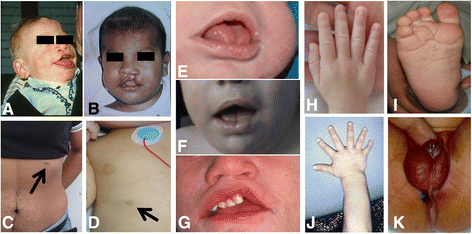Simpson-Golabi-Behmel syndrome types I and II
- PMID: 25238977
- PMCID: PMC4254265
- DOI: 10.1186/s13023-014-0138-0
Simpson-Golabi-Behmel syndrome types I and II
Abstract
Simpson-Golabi-Behmel syndrome (SGBS) is a rare overgrowth syndrome clinically characterized by multiple congenital abnormalities, pre/postnatal overgrowth, distinctive craniofacial features, macrocephaly, and organomegaly. Abnormalities of the skeletal system, heart, central nervous system, kidney, and gastrointestinal tract may also be observed. Intellectual disability, early motor milestones and speech delay are sometimes present; however, there are a considerable number of individuals with normal intelligence.
El Síndrome de Simpson-Golabi-Behmel (SSGB) es un síndrome de sobrecrecimiento raro, que se caracteriza clínicamente por múltiples anomalías congénitas, sobrecrecimiento pre y post natal, rasgos craneofaciales distintivos, macrocefalia y organomegalia. Otras características que pueden presentar estos pacientes incluyen anomalías en el aparato esquelético, el corazón, el sistema nervioso central, el riñón y el tracto gastrointestinal. También pueden presentar discapacidad intelectual, retraso motor precoz y retraso en el habla, aunque en su mayoría, estos individuos presentan una inteligencia dentro de los límites normales.
Los reordenamientos genómicos y las mutaciones puntuales que incluyen el gen GPC3 (“Glypican-3 gene”) localizado en la región cromosómica Xq26, se han asociado con la aparición del SSGB. Ocasionalmente, estos reordenamientos genómicos pueden incluir el gen GPC4. Los glipicanos son proteoglicanos de heparán sulfato que actúan controlando el crecimiento y división celular.
Aunque se ha descrito una forma letal de este síndrome (denominada SSGB tipo II) en esta revisión sólo analizamos la forma clásica de este síndrome y sólo comentaremos algunos aspectos del SSGB tipo II.
En este trabajo se presenta una revisión de todos los aspectos clínicos y moleculares de este síndrome, actualizando algunos aspectos y además se sugiere un esquema de seguimiento de estos pacientes por parte de genetistas y médicos de atención primaria.
Figures

Similar articles
-
A patient with Simpson-Golabi-Behmel syndrome, biliary cirrhosis and successful liver transplantation.Am J Med Genet A. 2014 Mar;164A(3):774-7. doi: 10.1002/ajmg.a.36335. Epub 2013 Dec 19. Am J Med Genet A. 2014. PMID: 24357529
-
CUGC for Simpson-Golabi-Behmel syndrome (SGBS).Eur J Hum Genet. 2019 Apr;27(4):663-668. doi: 10.1038/s41431-019-0339-z. Epub 2019 Jan 25. Eur J Hum Genet. 2019. PMID: 30683921 Free PMC article.
-
Simpson-Golabi-Behmel syndrome with 46,XY disorders of sex development: A case report.Am J Med Genet A. 2019 Feb;179(2):285-289. doi: 10.1002/ajmg.a.40669. Epub 2019 Jan 22. Am J Med Genet A. 2019. PMID: 30667571
-
Distinctive findings in a boy with Simpson-Golabi-Behmel syndrome.Am J Med Genet A. 2016 Apr;170A(4):1035-9. doi: 10.1002/ajmg.a.37518. Epub 2015 Dec 22. Am J Med Genet A. 2016. PMID: 26692054 Review.
-
Simpson-Golabi-Behmel syndrome in one of the Dichorionic-diamniotic twin: a case report and literature review.BMC Pregnancy Childbirth. 2022 Jan 17;22(1):42. doi: 10.1186/s12884-021-04309-z. BMC Pregnancy Childbirth. 2022. PMID: 35038998 Free PMC article. Review.
Cited by
-
Concomitant Wilms tumor and autosomal dominant polycystic kidney disease.Pediatr Blood Cancer. 2024 Oct;71(10):e31230. doi: 10.1002/pbc.31230. Epub 2024 Jul 31. Pediatr Blood Cancer. 2024. PMID: 39085996
-
Overgrowth syndromes - clinical and molecular aspects and tumour risk.Nat Rev Endocrinol. 2019 May;15(5):299-311. doi: 10.1038/s41574-019-0180-z. Nat Rev Endocrinol. 2019. PMID: 30842651 Review.
-
SGBS cells as a model of human adipocyte browning: A comprehensive comparative study with primary human white subcutaneous adipocytes.Sci Rep. 2017 Jun 22;7(1):4031. doi: 10.1038/s41598-017-04369-2. Sci Rep. 2017. PMID: 28642596 Free PMC article.
-
Simpson-Golabi-Behmel syndrome type 1 in a neonate with central hepatoblastoma.BMJ Case Rep. 2025 Jan 29;18(1):e262331. doi: 10.1136/bcr-2024-262331. BMJ Case Rep. 2025. PMID: 39880477 Free PMC article.
-
The Extracellular Matrix and Neuroblastoma Cell Communication-A Complex Interplay and Its Therapeutic Implications.Cells. 2022 Oct 10;11(19):3172. doi: 10.3390/cells11193172. Cells. 2022. PMID: 36231134 Free PMC article. Review.
References
-
- Simpson JL, Landey S, New M, German J. A previously unrecognized X-linked syndrome of dysmorphia. Birth Defects Orig Artic Ser. 1975;11:18–24. - PubMed
Publication types
MeSH terms
Supplementary concepts
LinkOut - more resources
Full Text Sources
Other Literature Sources
Medical

